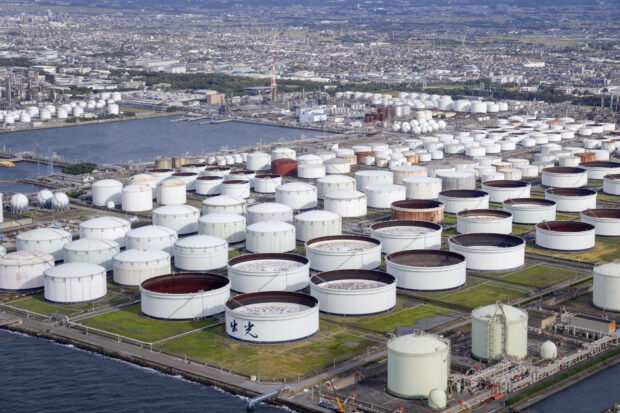
An aerial view shows of oil tanks of Idemitsu Kosan Co. in Ichihara, east of Tokyo, Japan Nov 12, 2021, in this photo taken by Kyodo. Picture taken on November 12, 2021. Mandatory credit Kyodo/via REUTERS/File photo
TOKYO – Oil prices rebounded more than 1 percent on Wednesday, recovering from the previous day’s plunge, as a stronger OPEC outlook on China’s demand helped offset bearish global investor sentiment in the wake of the recent U.S. bank failures.
Brent crude futures climbed 93 cents, or 1.2 percent, to $78.38 a barrel by 0324 GMT. U.S. West Texas Intermediate crude futures (WTI) gained 96 cents, or 1.4 percent, to $72.29 a barrel. On Tuesday, the benchmarks fell more than 4 percent to a three-month low.
“The oil market has bounced back on its own after the recent sharp losses,” said Toshitaka Tazawa, an analyst at Fujitomi Securities Co Ltd, adding some investors had taken advantage of the slide to hunt for bargains.
“The OPEC upgrade in Chinese oil demand outlook also lent support, though investors were still concerned over a cascading financial crisis after the recent collapse of U.S. banks,” he said, noting that whether WTI can stay above $70 a barrel is being closely watched.
The Organization of the Petroleum Exporting Countries (OPEC on Tuesday further raised its forecast for Chinese oil demand growth in 2023 due to the relaxation of the country’s COVID-19 curbs, although it left the global demand total steady, citing potential downside risks for world growth.
Chinese refineries processed 3.3 percent more crude in the first two months of 2023 compared with the same period a year earlier, data showed on Wednesday, spurred by fuel export policy and independent refiners processing more in response to improving margins for transportation fuels after Beijing lifted COVID restrictions.
China’s demand recovery is bullish for oil prices, said Stefano Grasso, a senior portfolio manager at 8VantEdge in Singapore.
“The consensus is that the oil supply-demand balance will tighten in the second half, driven by China rebound, unless a severe global recession hits,” he added.
The failure of Silicon Valley Bank and Signature Bank triggered concerns about risks to other banks resulting from the U.S. Federal Reserve’s sharp interest rate hikes over the last year. That also spurred speculation about whether the central bank could slow the pace of its monetary tightening.
On Tuesday, the U.S. inflation data came in line with expectations, bolstering bets on a smaller interest rate hike by the Fed at its meeting next week.
Meanwhile, U.S. crude oil inventories rose by about 1.2 million barrels in the week ended March 10, in line with a Reuters poll, while fuel stockpiles fell, according to market sources citing American Petroleum Institute figures on Tuesday.
On the supply side, Saudi Arabia’s energy minister Prince Abdulaziz bin Salman told Energy Intelligence in an interview on Tuesday the OPEC+ alliance – OPEC and allied oil producers including Russia – will stick to production cuts agreed in October until the end of the year.
The International Energy Agency (IEA) will publish its monthly report later on Wednesday and the U.S. Energy Information Administration will publish weekly inventory data at 10:30 a.m. EDT.
READ MORE:
Oil prices rise as China factory bounce boosts demand outlook

